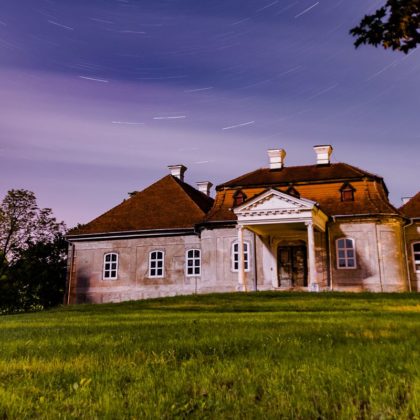Pohronie is a region of the drainage basin of the river Hron. 300 kilometers long, it is the second longest river in Slovakia. Its spring can be found not far from Telgárt, and it flows into the Danube. The first shepherd tribes settled in its drainage basin in the middle of the 2nd millennium BC and learned how to use copper ores in the river’s valley. From the 17th century to the 1930’s, cargo of timber was floated on the Hron and its tributaries; important roads ran through the valley already during the Roman Period.
Today, the Hron on its way runs through 72 towns and villages, including Želiezovce and Jur nad Hronom. Even though Hron isn’t navigable for either freight nor passenger ships, it is navigable for canoes, rafts or kayaks. Everything you need for such adventure can be found in Jur nad Hronom.
Hello!
Directly by the river there is Camping Vodník, which offers accommodation in simple cabins, caravans or tents. Can you also hear the guitar, rambler songs and smell the aroma of smoke and fried bacon in your head when you think of camping? That’s exactly how it comes alive at the start of the season with the voices of visitors – families, colleagues and friends, who came to experience a little wilderness.
Camping Vodník offers not only accommodation, but also basic infrastructure, hygiene and catering, the option to buy drinks, grill and barbecue and games for children. It’s a great starting point for trips to the surroundings in the Tekov region. Visitors needn’t be at a loss as to where and how to go, because all information is willingly provided by the camp’s manager.
Camping Vodník is a favourite paddlers’ destination, who can sail down and pass from Jur nad Hronom to Želiezovce or even to the Danube, to Štúrovo. River rafting is possible in the opposite direction as well – from Kalná nad Hronom to the home base. Camp workers can willingly drive you to Kalná nad Hronom by appointment and if you don’t have your own paddlers’ equipment, you can borrow everything necessary on site.
Sailing down the river will be safe if you follow the instructions and experience of camp workers. But beware! As the boss of Camping Vodník and lifelong paddler pointed out to us, the view of the world from water is completely different. Maybe you’ll become enthusiastic paddlers after your first passage as well.
https://www.facebook.com/campvodnik/
https://www.campingvodnik.sk
Folk House Duba Tájház
The authentic house of the Dubovci family is also located in Jur nad Hronom. It’s no open-air folk museum, but the original house from 1860. It is completely furnished with hundreds of items from everyday life of the household. The kitchen, the room, the storeroom and the stove transfer visitors to the times when the whole family used to meet and live in the house.
Wardrobes full of period clothing and everyday items create the impression that one only needs to move in again and the house will come alive.
A well-maintained farmstead belongs to the house as well and the visitors can see numerous original farming tools. One of the house’s rooms is a furnished school classroom with rich pedagogical documentation from the 1900’s.
The house’s surroundings are picturesque, they radiate peace and prove long-time loving care of their owners. All I can do is say thank you for preserving this piece of history for us. How? The best way is by genuine interest in and respect for troubled fortunes and times which people have experienced in the last 150 years.
https://www.ajdnes.sk/ludovy-dom-duba–duba-tajhaz/jur-nad-hronom/l11838
The House of Battle Glory
The Pohronie region was inspirational not only for Franz Schubert. It inspired Marcus Aurelius too, a Roman emperor with the unwritten title Philosopher King. During one of his military campaigns around year 168 around the river Hron, he wrote the opening sentences of the 12-book cycle which is known today as “Meditations”. The timeless work dealing with stoic thoughts still speaks to readers today.
One of the relics reminding the battles of Roman armies near the Hron is the Column of Marcus Aurelius in Rome, which depicts scenes from battles in this territory. However, these battles were not the only ones witnessed by the river Hron.
On March 25, 1945, the Bratislava-Brno Offensive commenced. The river in Kalná nad Hronom became the key place in the liberation battles. History enthusiasts are certainly aware of the Offensive, the rest of us can pay our respects to the liberators by visiting the House of Battle Glory in Kalná nad Hronom.
The place is not only a memorial site, but also an exposition with detailed overview about the liberation battles including period weapons, maps and written documents. The sight of a long list of names and weapons, now harmlessly lying in display cases, unwittingly moves a person. I personally read with interest the original period written documents, which, using plain bureaucratic style, suggested how common people in nearby villages lived, too.
The premises of the House of Battle Glory are easy to recognize – you can see war equipment in its courtyard, which is located near the main road Levice – Nitra.
https://cs.wikipedia.org/wiki/Bratislavsko-brněnská_operace
https://regiontekov.info/portfolio/dom-bojovej-slavy
Time in Pohronie
On the banks of the Hron sat Marcus Aurelius, Franz Schubert, the armies of various nations and today even us. Pohronie is a magical place, where perceptive visitors feel history almost tangibly. So much happened! A river flows like human life, like time. So, safe passage and visit Pohronie sometime!








